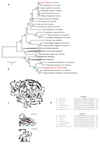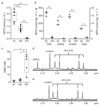Mutations in SELENBP1, encoding a novel human methanethiol oxidase, cause extraoral halitosis
- PMID: 29255262
- PMCID: PMC5742538
- DOI: 10.1038/s41588-017-0006-7
Mutations in SELENBP1, encoding a novel human methanethiol oxidase, cause extraoral halitosis
Abstract
Selenium-binding protein 1 (SELENBP1) has been associated with several cancers, although its exact role is unknown. We show that SELENBP1 is a methanethiol oxidase (MTO), related to the MTO in methylotrophic bacteria, that converts methanethiol to H2O2, formaldehyde, and H2S, an activity not previously known to exist in humans. We identified mutations in SELENBP1 in five patients with cabbage-like breath odor. The malodor was attributable to high levels of methanethiol and dimethylsulfide, the main odorous compounds in their breath. Elevated urinary excretion of dimethylsulfoxide was associated with MTO deficiency. Patient fibroblasts had low SELENBP1 protein levels and were deficient in MTO enzymatic activity; these effects were reversed by lentivirus-mediated expression of wild-type SELENBP1. Selenbp1-knockout mice showed biochemical characteristics similar to those in humans. Our data reveal a potentially frequent inborn error of metabolism that results from MTO deficiency and leads to a malodor syndrome.
Conflict of interest statement
Competing Financial Interests
The authors have no competing interests as defined by Springer Nature, or other interests that might be perceived to influence the results and/or discussion reported in this paper.
Figures





References
-
- Tangerman A, Winkel EG. The portable gas chromatograph OralChroma: a method of choice to detect oral and extra-oral halitosis. J Breath Res. 2008;2 017010. - PubMed
-
- Tangerman A, Winkel EG. Intra- and extra-oral halitosis: finding of a new form of extra-oral blood-borne halitosis caused by dimethyl sulphide. J Clin Periodontol. 2007;34:748–55. - PubMed
-
- Tangerman A, Winkel EG. Extra-oral halitosis: an overview. J Breath Res. 2010;4 017003. - PubMed
-
- Harvey-Woodworth CN. Dimethylsulphidemia: the significance of dimethyl sulphide in extra-oral, blood borne halitosis. Br Dent J. 2013;214:E20. - PubMed
Publication types
MeSH terms
Substances
Grants and funding
LinkOut - more resources
Full Text Sources
Other Literature Sources
Medical
Molecular Biology Databases
Research Materials

